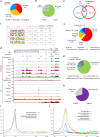The chromatin remodeller ATRX facilitates diverse nuclear processes, in a stochastic manner, in both heterochromatin and euchromatin
- PMID: 35710802
- PMCID: PMC9203812
- DOI: 10.1038/s41467-022-31194-7
The chromatin remodeller ATRX facilitates diverse nuclear processes, in a stochastic manner, in both heterochromatin and euchromatin
Abstract
The chromatin remodeller ATRX interacts with the histone chaperone DAXX to deposit the histone variant H3.3 at sites of nucleosome turnover. ATRX is known to bind repetitive, heterochromatic regions of the genome including telomeres, ribosomal DNA and pericentric repeats, many of which are putative G-quadruplex forming sequences (PQS). At these sites ATRX plays an ancillary role in a wide range of nuclear processes facilitating replication, chromatin modification and transcription. Here, using an improved protocol for chromatin immunoprecipitation, we show that ATRX also binds active regulatory elements in euchromatin. Mutations in ATRX lead to perturbation of gene expression associated with a reduction in chromatin accessibility, histone modification, transcription factor binding and deposition of H3.3 at the sequences to which it normally binds. In erythroid cells where downregulation of α-globin expression is a hallmark of ATR-X syndrome, perturbation of chromatin accessibility and gene expression occurs in only a subset of cells. The stochastic nature of this process suggests that ATRX acts as a general facilitator of cell specific transcriptional and epigenetic programmes, both in heterochromatin and euchromatin.
© 2022. The Author(s).
Conflict of interest statement
The authors declare no competing interests.
Figures





References
-
- Clynes D, Higgs DR, Gibbons RJ. The chromatin remodeller ATRX: a repeat offender in human disease. Trends Biochem Sci. 2013;38:461–466. - PubMed
-
- Gibbons RJ, et al. Mutations in ATRX, encoding a SWI/SNF-like protein, cause diverse changes in the pattern of DNA methylation. Nat. Genet. 2000;24:368–371. - PubMed
-
- Law MJ, et al. ATR-X syndrome protein targets tandem repeats and influences allele-specific expression in a size-dependent manner. Cell. 2010;143:367–378. - PubMed
Publication types
MeSH terms
Substances
Supplementary concepts
Grants and funding
- MR/T014067/1/MRC_/Medical Research Council/United Kingdom
- MC_U137961145/MRC_/Medical Research Council/United Kingdom
- MC_PC_14131/MRC_/Medical Research Council/United Kingdom
- MC_U137961147/MRC_/Medical Research Council/United Kingdom
- MC_U137961144/MRC_/Medical Research Council/United Kingdom
- MC_PC_15069/MRC_/Medical Research Council/United Kingdom
- G1000801/MRC_/Medical Research Council/United Kingdom
- MR/M00919X/1/MRC_/Medical Research Council/United Kingdom
- MC_UU_12009/4/MRC_/Medical Research Council/United Kingdom
- MC_UU_12025/MRC_/Medical Research Council/United Kingdom
- G0902418/MRC_/Medical Research Council/United Kingdom
- MC_UU_00016/12/MRC_/Medical Research Council/United Kingdom
- MC_EX_MR/R023301/1/MRC_/Medical Research Council/United Kingdom
- MC_UU_12009/3/MRC_/Medical Research Council/United Kingdom
- MC_UU_00016/3/MRC_/Medical Research Council/United Kingdom
- MC_UU_00016/4/MRC_/Medical Research Council/United Kingdom
- MC_UU_12009/13/MRC_/Medical Research Council/United Kingdom
- MR/K01577X/1/MRC_/Medical Research Council/United Kingdom
LinkOut - more resources
Full Text Sources
Molecular Biology Databases
Miscellaneous

